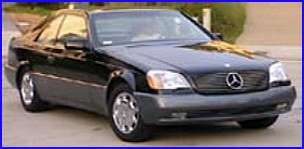Diagnosis and Repair of the 1994 Hydraulic Suspension System
The suspension system consists of two shock absorbers in the front of the car and two hydraulic struts in the rear of the car.
The front absorbers are the traditional type and there's no need to explain them since they work 'by-themselves' as they are
conventually oil filled and self contained.
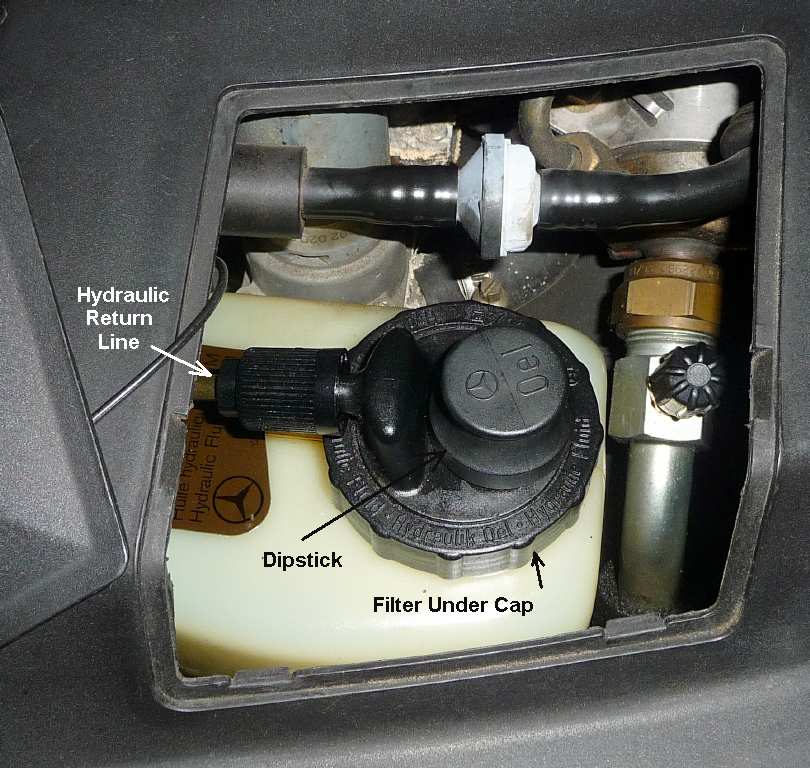 The rear shocks are hydraulic struts and there are a lot of components in this part of the system. These struts have a supply
line feeding them with hydraulic oil pressurized by the power steering pump.
The rear shocks are hydraulic struts and there are a lot of components in this part of the system. These struts have a supply
line feeding them with hydraulic oil pressurized by the power steering pump.
Under the hood on the right side of the engine under a removable cover, there is a small reservoir that holds the hydraulic oil
as shown in the picture. You should REGULARLY check the fluid level with the car fully warmed and running by
removing the cap which exposes that it's a dipstick. There are two marks; MIN and MAX. The fluid level should be
between these two marks.
I have not checked this level in 5+ years! And the last time the suspension system was flushed was in 2010, 9 years ago!
Since I don't drive it alot these days, why would I need to check these things?
About 2 months ago, I noticed that the rear end was low, barely sitting above the back tires. This is somewhat normal b/c if
the car sits for a long time (a month or more), the hydraulic pressure will drop, causing the rear end to sag. But it
should not be readily visible! At the time I thought this was normal!!
When I started the car, the rear end rose quickly and so all was OK, so I thought. I didn't notice that it would not
come up all-the-way to where it used to rise. It would rise comfortablely above the rear tire width so there was no
"rubbing". However yesterday, I saw the small puddle of hydraulic fluid on the garage floor near the right rear wheel.
Pneumatic Suspension System Operation
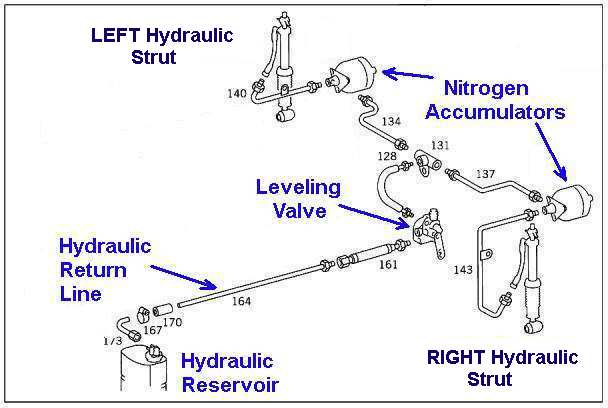 The power steering pump is used for two systems, one for the steering, and the other for the rear suspension oil. The
pressurized oil is sent to a valve near the rear of the car. This valve is attached to the under body of the car. The valve
lever is attached to the rear axle. As long as the car is at the correct height, there is no movement of the arm relative to
the valve. However, as soon as extra weight is put into the car, the body squats down. This motion causes the arm on the valve
to move, and that opens the supply port for the pressurized hydraulic oil. The oil passes through the valve, and eventually
makes it's way into the struts. Since oil is being forced into the struts, they begin to fill up and lengthen. This raises the
car until the valve arm is back into normal position, which stops the supply of oil. This is how the vehicle maintains the
proper ride height in the rear.
The power steering pump is used for two systems, one for the steering, and the other for the rear suspension oil. The
pressurized oil is sent to a valve near the rear of the car. This valve is attached to the under body of the car. The valve
lever is attached to the rear axle. As long as the car is at the correct height, there is no movement of the arm relative to
the valve. However, as soon as extra weight is put into the car, the body squats down. This motion causes the arm on the valve
to move, and that opens the supply port for the pressurized hydraulic oil. The oil passes through the valve, and eventually
makes it's way into the struts. Since oil is being forced into the struts, they begin to fill up and lengthen. This raises the
car until the valve arm is back into normal position, which stops the supply of oil. This is how the vehicle maintains the
proper ride height in the rear.
When the weight is removed, the same thing happens in reverse. The valve arm moves in the opposite direction, which causes
the valve to open a drain port. Oil is allowed out of the struts back into the system, and they get shorter again. Motion stops
once the proper ride height is reached.
With a hydraulic system like this, there is no shock absorbing capability. Since the fluid will not compress, something else is
needed to soften the ride! To accomplish a soft-ride, Mercedes used nitrogen accumulators as they are called. I have
replaced both apx 11 years ago. In the diagram, this is just the basic system with no-frills!
When I saw the fluid puddle on the garage floor, I checked the reservoir's dipstick and saw it was below the MIN value.
So looking down into the reservoir with the filter removed, the level was quite low . . . maybe 8 or more ounces low. That's
probably enough to account for a rupture of an accumulators' diaphragm or a nitrogen leak. It's time to investigate and get it
fixed.
The "FIX"!
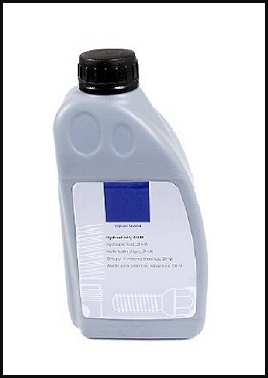
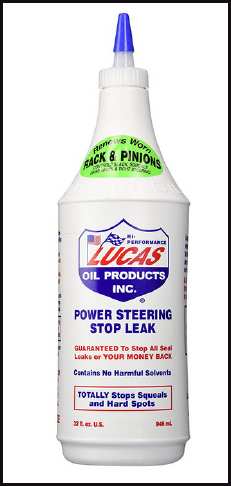 I have a bottle of the recommended fluid (MB Hydraulic Oil, PN 000989910310) and Lucas Power Steering Stop Leak.
Since the fluid hasn't been flushed, I needed some not-to-expensive hydraulic fluid so I purchased one gallon of Lucas
Hydraulic Fluid for a very reasonable price. I used this as the sacrificial fluid to be able to thoroughly flush the system
using the complete gallon if necessary. And was it dirty! And took quite a bit of the Lucas HF gallon before it was
clear *.
I have a bottle of the recommended fluid (MB Hydraulic Oil, PN 000989910310) and Lucas Power Steering Stop Leak.
Since the fluid hasn't been flushed, I needed some not-to-expensive hydraulic fluid so I purchased one gallon of Lucas
Hydraulic Fluid for a very reasonable price. I used this as the sacrificial fluid to be able to thoroughly flush the system
using the complete gallon if necessary. And was it dirty! And took quite a bit of the Lucas HF gallon before it was
clear *.
*: To perform a hydraulic fluid flush, unscrew the Return Line fitting and then add apx 4-5 ft
of clear plastic tubing (makes it easy to see the color change) and put the other end into a bucket. Also remove the FILTER
element by unscrewing the plastic nut so that you can see the fluid level.
Next, start the car and observe the old fluid being sent into the bucket. Add hydraulic fluid as needed to keep the reservoir
full. When the fluid turns 'clear', continue to pump until the reservoir is almost empty. Turn the engine off. Next add the
needed amount of hydraulic fluid to fill the reservoir up to the level that is just above the metal-holding-strap.
[Opt: for a strut leak, add 12 oz of Lucas SL first.] Remove the plastic drain hose and re-attach
to reservoir fitting after replacing the filter element. Add any needed amount of hydraulic fluid to get the dipstick level
between MIN and MAX.
|
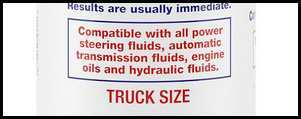 After flushing, I pumped the reservoir down until it was almost empty. Then I added apx 12 oz of Lucas Stop Leak. I should note
that it is compatible with all oils and hydraulic fluids so that's what gave me the security to do this as is shown on the back
of the bottle.
After flushing, I pumped the reservoir down until it was almost empty. Then I added apx 12 oz of Lucas Stop Leak. I should note
that it is compatible with all oils and hydraulic fluids so that's what gave me the security to do this as is shown on the back
of the bottle.
I filled the reservoir up with MB hydraulic fluid to bring it to a level between MIN and MAX as shown on the dipstick.
I went for a long ride . . . 50miles . . . and when I returned, the rear end was up to where it used to be . . . which I had
forgotten. And the best part, there was no leaks!!! Can you say . . pleased and happy! So it looks like the problem is
fixed but could be just temporary.
So over the 9 years of my car's minimal driving, the hydraulic fluid had deteriorated and some had evaporated due to a leak in
the system which caused the rear-end to drop and not be able to fully inflate the struts to gain the needed height. I guess you
can blame that on my neglect and non-driving.
Pushing down on the back bumper, the car "bounces" twice; it should just come back to neutral or, when 'cold', may exhibit one
gentle overshoot. This is confirmed by the "bouncy" ride. A simple test; go SLOWLY over SPEED BUMPS in a parking lot. If
the car bounces, then the accumulators need to be replaced. It's been apx 12 years since they were replaced for the first
time.
UPDATE: After two weeks of driving, I did another flush to drain all of the previous fluids. It was very "red" colored due to
the Lucas SL. When it pumped clear, the required amount of hydraulic fluid was added w/o Lucas SL, to bring the level to
between MIN and MAX. Currently driving w/o problems, no leaks and no sag after sitting for 48 hours!
I got underneath the rear end so I could see what's what! It looks like the right strut has leaked (puddle on the garage
floor) but it has sealed itself with the flushing + new hydraulic fluid described above. It appears that the LOW fluid
level caused the strut seals to dry-out and thus the leak. The fact that they are NOT leaking now seems to confirm that.
Time will tell if that's correct.
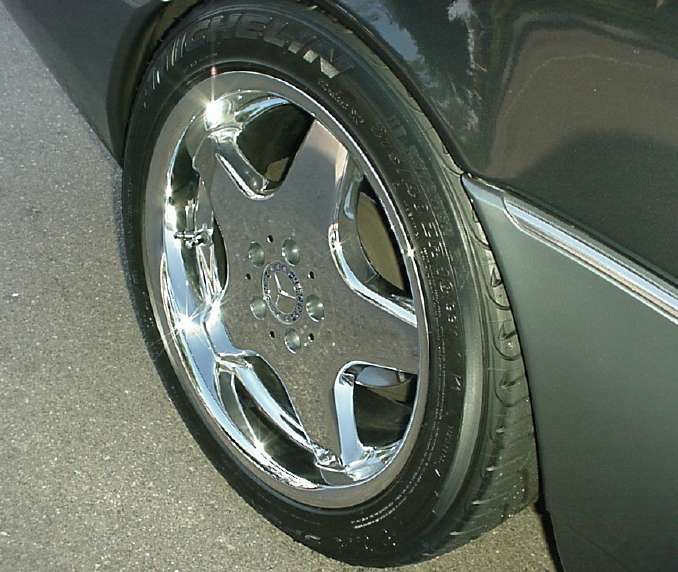 I have ordered new accumulators and will replace them in a few days. I'm looking for a used Sachs strut (140 320 96 13) to
replace the right side. But I won't need it if the 'repaired' strut continues to perform as it does now.
I have ordered new accumulators and will replace them in a few days. I'm looking for a used Sachs strut (140 320 96 13) to
replace the right side. But I won't need it if the 'repaired' strut continues to perform as it does now.
The new rear acculumators were replaced today (appear to be made by Febi Bilstein) and the ride is what it used to be!! No more
'bouncing'! So both of them were 'broken'. An interesting fact seemed to emerge: it's almost
IMPOSSIBLE to test them b/c even if both bladders APPEAR to be solid and not broken, you can't say that both acculumators
are ok!!
The picture shows a learned MB tech testing an accumulator to verify its operational readiness. But BE AWARE, that this test
is NOT VALID!!!!
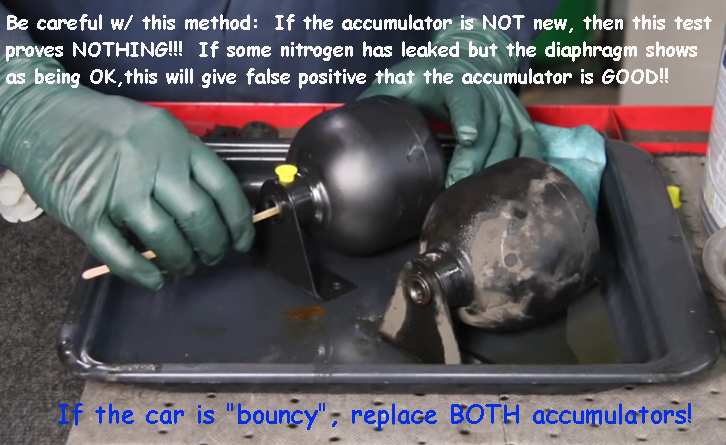 They could have LEAKED some of the nitrogen and reduced pressure will render them useless even though you can press on the
bladder and it shows "resistance". If you cut them open, you still can't be sure that they are good! Obviously after
you open it, it's "dead" . . but I mean that even if the bladders appear OK, you can't ever know about the nitrogen.
Think about that for a minute. So bottom line, if the car "bounces", the accumulators MUST be replaced and
they should be done in PAIRS!
They could have LEAKED some of the nitrogen and reduced pressure will render them useless even though you can press on the
bladder and it shows "resistance". If you cut them open, you still can't be sure that they are good! Obviously after
you open it, it's "dead" . . but I mean that even if the bladders appear OK, you can't ever know about the nitrogen.
Think about that for a minute. So bottom line, if the car "bounces", the accumulators MUST be replaced and
they should be done in PAIRS!
The cost??? Bottom line is: 2 - accumulators = $200; labor to replace same = $300; fluids/misc = $100 for a total cost of
$600. Not bad to have the SLS system operational. A good trade-off vs replacing the SLS suspension with a conventional
spring/shock combo costing apx $1000 - $1300 with labor considered.
The picture showing the right rear tire was taken in 2007 and shows the oversize tire, 275x40x18 mounted with
just enough clearance even for that large oversize tire.
Conclusions
It's been over one month since the leaking right rear strut was 'fixed'. First Lucas SL was employed for two (2) weeks, then it
was flushed out and replaced with normal hydraulic fliud. Now, a month later, there aren't any leaks from that strut.
The theory that the seals were dried out b/c of the low fluid appears to be correct and, even better, it
appears that it has been fixed in my case. The cause of this was the failed accumulators; the hydraulic fluid was depleted when
the accumulator's diaphragm(s) failed causing the overall hydraulic fluid level to drop. Since I didn't drive alot, the car sat
there for extended periods causing the strut seals to dry out and subsequently leak. Based on this, I'm positive that this
"repair" can be repeated so it's worth a try before scrapping the strut.
New Tires
Recently, I replaced my 12 year old tires with four (4) new Michelin Sport AS 3+ tires. After riding on them for a
week, the car rode pretty "hard" plus there was a 'Steering-Wheel-Wiggle' [SWW] @ 45mph and a thump which could be felt
to about 65mph. That usually is a sure sign of out-of-balance front tire(s) and/or an out-of-round tire. One thing for sure,
there's a big difference in the early Pilot Sport tire and these new Sport AS 3+ tires. So back they go!
As a side-note, I did experience a SWW (but no thump) with the older Pilot Sport. After a lot of re-balancing and tire
swapping, it was minimized but never fully went away! Joe-V12, a BenzWorld member stated the following:
"I've had seven 140s. On every single one the 50mph vibration was the wheels/tires."
I've switched them out for four (4) Michelin Primacy MXM4 tires. As reported on many sites, there is a immediately
observable difference in the Primacy vs Sport 3+. There isn't any SWW or thumping. It's just a smooth ride due to the
tire's construction and sidewall flexability which I believe emulates the large wall of a stock tire. It has the effect of
attenuating any road force imbalance present in the tire. It also a much better constructed tire with neutral tread pattern.
It's rated as a "touring" tire which works well for my driving style. I do recommend them!
Please note that the tire that was ordered has a LOAD INDEX = 96V versus the same tire with a LOAD INDEX =
100W. The former tire is rated for TIRE WEAR of 55,000 miles vs 45,000 miles for the latter. The COST is $235 vs $185 -
$50 more/tire!! I did NOT pay for the "mistake" in the order but have the better tires (96V) on the car!
|
Power Steering Repair
This is not the end of the story: I thought that this article would be a good place to relate two (2) stories of a power
steering pump leak repair!
'94 S500 Coupe
It was diagnosed at a routine oil change. You could see the PS oil 'slick' in the area. It looked to be the PS pump, not the
rack and pinion. So when I got home, I drained the old fluid, cleaned the filter and filled the reservoir with the required
amount of Lucas PS Stop Leak fluid. Apx one year later, when I went for an oil change, there wasn't even one drop of PS fluid
to be found. And that was at least 6 years ago!! Today, my S500 coupe's power steering is still as good as new and there
isn't a drop on the garage floor today!
'90 Honda Accord Lx
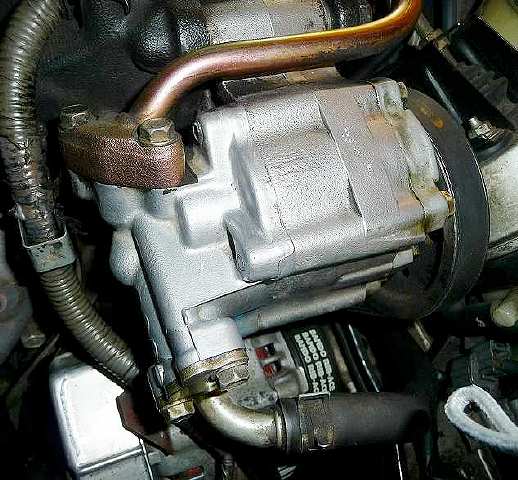 It doesn't end here: also used it to fix a PS leak on the 1990 Honda Accord Lx. The tech noticed that there was some drops coming
from the PS pump and sure enough, it was leaking from the front seal producing the tell-tale oil line on the inside of the hood!
And from the line's 'depth', it had been leaking for some time! So I drained the old fluid and replaced with apx 50% Lucas Stop
Leak. And it stopped!
It doesn't end here: also used it to fix a PS leak on the 1990 Honda Accord Lx. The tech noticed that there was some drops coming
from the PS pump and sure enough, it was leaking from the front seal producing the tell-tale oil line on the inside of the hood!
And from the line's 'depth', it had been leaking for some time! So I drained the old fluid and replaced with apx 50% Lucas Stop
Leak. And it stopped!
If this appears to be a blanket recommendation for Lucas Oil Products, you would be correct! And why wouldn't it? In the three
(3) instances that I have used that product, I'm batting 1000! I recommend that you try this if necessary before replacing
parts! Who knows . . . I'd be surprised if you didn't have similar results.
|
Send me  with your comments
with your comments
|

